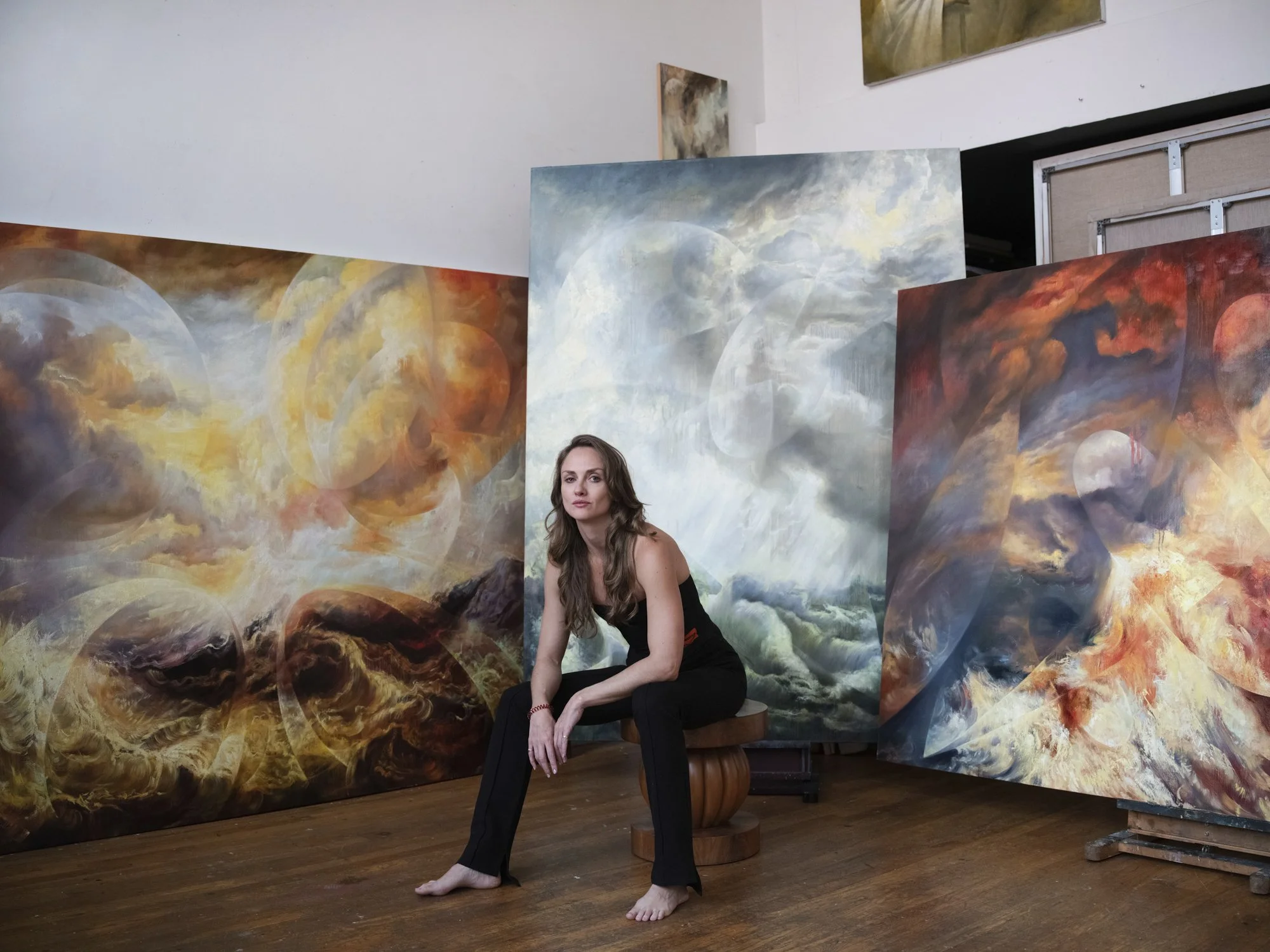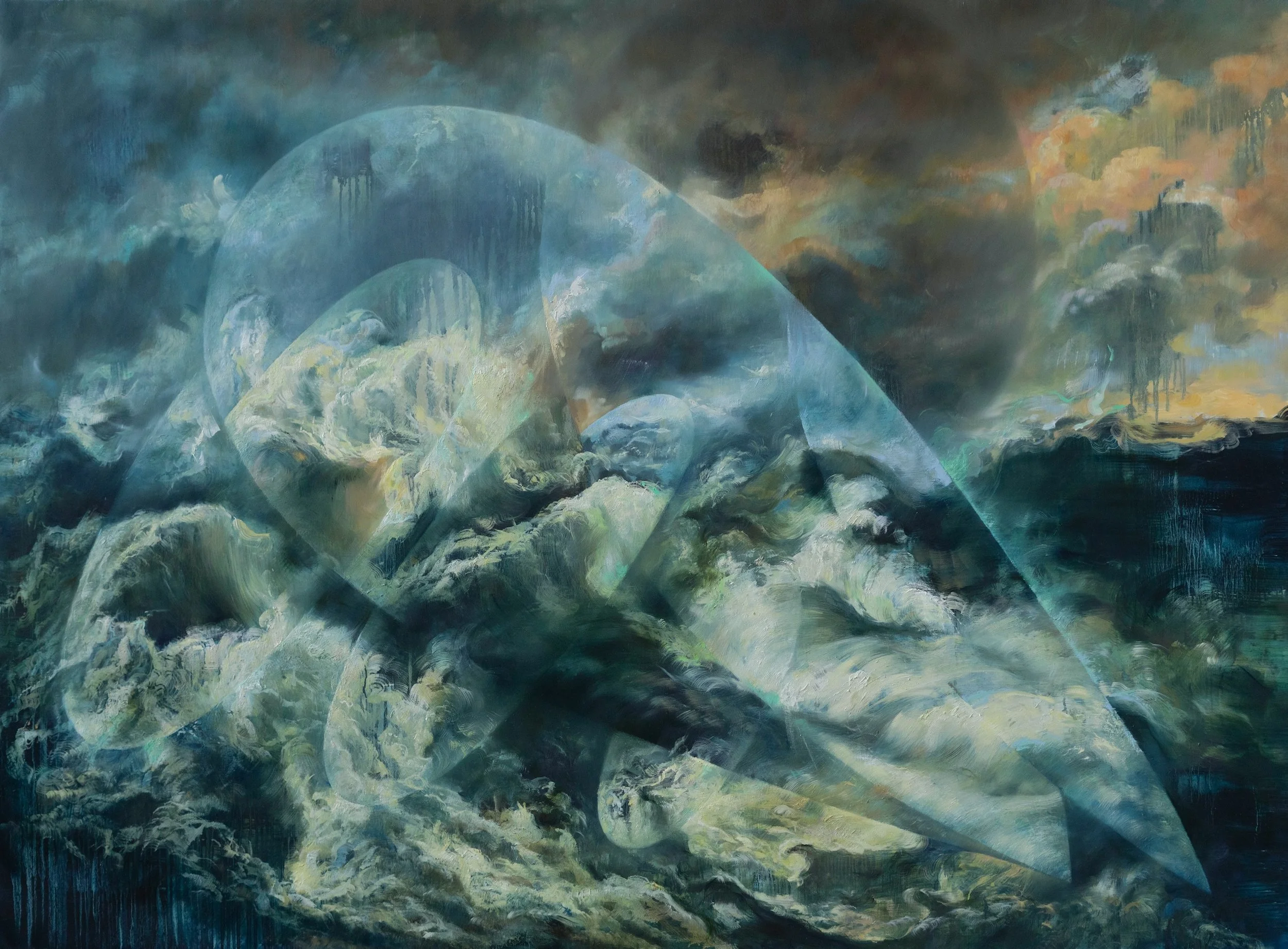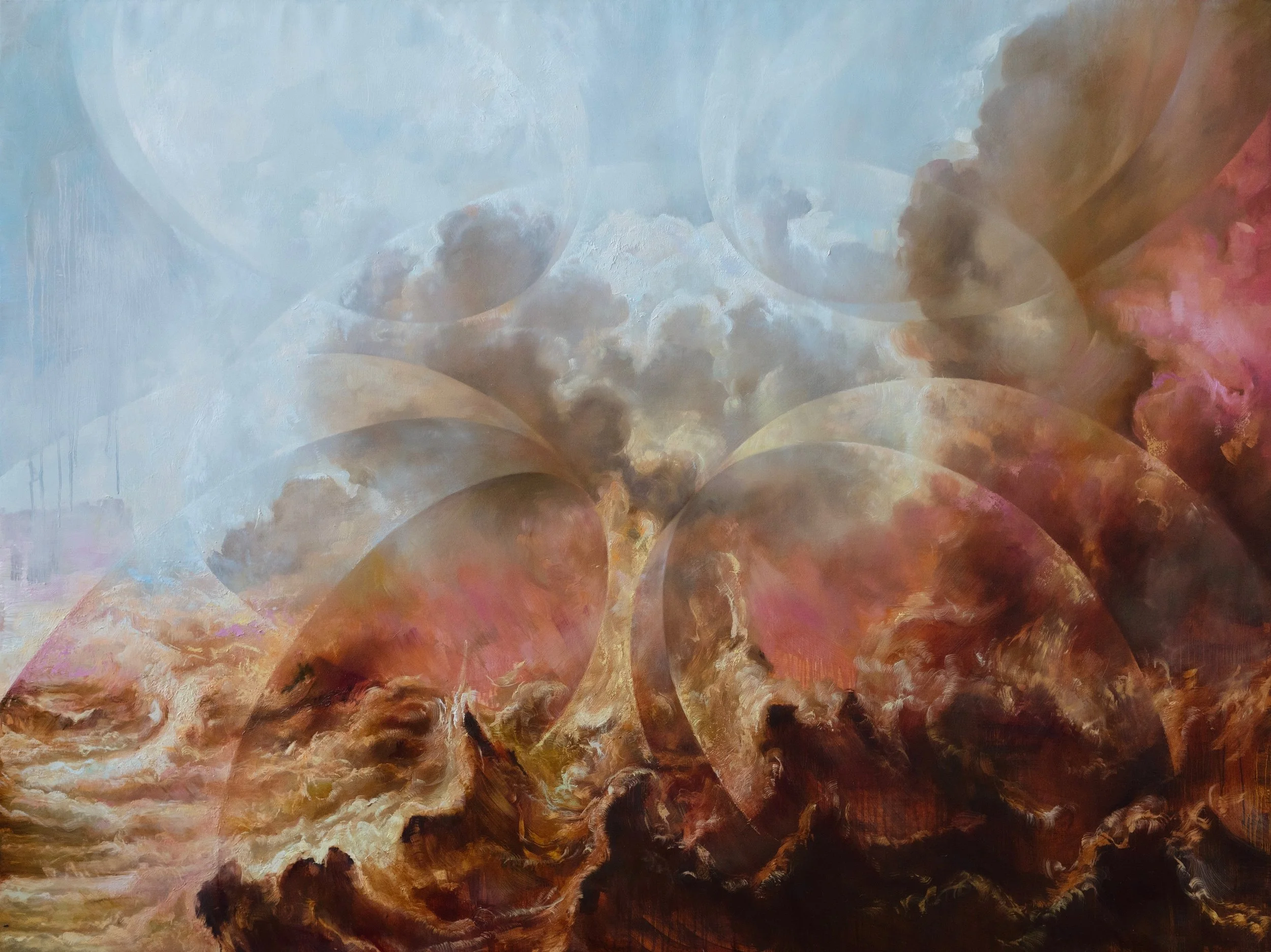In Conversation with Maria Kreyn
Photo Credit: Frank Martinez
Maria Kreyn (b. 1987) is an American artist whose emotionally charged works merge figuration, geometry, and elemental atmospherics. Internationally collected, she has created monumental commissions, including a Shakespeare-inspired cycle for London’s Theatre Royal Drury Lane. In 2024, she presented a solo exhibition at St. George’s Church during the Venice Biennale. She lives and works in Brooklyn, New York. She studied mathematics and philosophy at the University of Chicago and is self-taught in painting.
RENATA: Your exhibition takes its title from Timothy Morton’s concept of the “hyperobject.” How do you see painting as a medium uniquely suited to grappling with phenomena so vast—like climate change or deep time—that they exceed human perception?
MARIA: Painting is such a capacious, elliptical medium. Like music, it has a way of moving us emotionally without necessarily relying on specific syntax or iconography. It’s a space of mystery, or a portal or pinhole into the mystery.
The Hyperobject in this context is also a mysterious object—omnipresent, but not fully seen at once. It’s durable, yet beyond the edge of our intuition and knowledge. We get only tiny pinholes into limited facets of its nature at any given moment. Take the idea of Deep Time. Attempting to think and intuit beyond the anthropocentric conditioning we inherit in human culture is an attempt to think beyond what we can think. Painting has the capacity to push us into that inquiry.
Ocean Prism I. 60 x 80 inches. Oil on linen. 2024 Courtesy of the artist
R: In Hyperobject, you imagine human emotions themselves as hyperobjects. Could you expand on how you see our inner worlds—our feelings, our consciousness— mirroring the complexity of cosmic systems?
M: My conceit here is that human scales are entangled with cosmic scales. I’m playing with the notion of a fractal universe in which these inner and outer dimensions somehow rhyme, are perhaps wrapped up in each other, dance or unfold together.
Weather itself is a profound metaphor for the human condition — a dynamical system that can be seen in parts, but not fully understood. Thus climate change has a runaway butterfly effect, and eludes us as much as it meets us. Our consciousness is immediately present to us, yet even still, we find labyrinthine spaces in our own minds that are hardly known or accessible, seem generationally entangled, and cascade and transform like the weather.
Lensed Egg. 60 x 54 inches. Oil on linen. 2024 Courtesy of the artist
R: Your storm paintings hover between chaos and control. How do these storms act as metaphors for both human cognition and the limits of reason?
M: We are pattern-seeking primates. Our minds aim to make sense of the world— to categorize, name, contain, reduce. And yet we’re concurrently primed for awe, for enchantment, for gravitating towards mystery. I love the meeting of these two forces— both conceptually, and in the practice of painting. I love seeing where my controlled skill-set with the medium meets the place where the paint simply dissolves into the chaotic patterns of its own physics. It’s the place where our desire to understand ourselves as reasoning beings meets the incalculability of a dynamical system.
Whirling Fire. 80 x 60 inches. Oil on linen. 2025 Courtesy of the artist
R: How do you navigate translating abstract, scientific ideas—such as mathematics, philosophy, and neuroscience—into the visual language of abstract painting without reducing their complexity?
M: Coming from a STEM background, I have a deep respect for science, for the inquiry, and for the scientific method. These paintings are visual puzzles and games exploring our understanding of ideas at the edges of our objective inquiry, where our intuitions and our data still feel mysterious.
The works are themselves dreamlike, open-ended, without reductive answer or prescription. And like systems of weather, they are less about objective calculation, and more about the seemingly incalculable nature of dynamical systems. The paintings are visual and philosophical puzzles, asking questions like: what does the world look like if your eyeball is a prism, not a sphere? Or what if space-time is more like an origami, and you are able to unfold it?
Rose Flare. 60 x 80 inches. Oil on linen. 2024 Courtesy of the artist
R: This exhibition unfolds within the Byzantine-inspired Fitzrovia Chapel, your fourth solo presentation in a place of worship. How does situating your work in spaces of reverence shift or expand the way audiences encounter your paintings?
M: We are pre-primed for reverence in a church, but many of us are also skeptical of it. I love working in and with these spaces. Its a collaboration, and it’s also a benevolent coup. To ride the emotional wave of a religion without any of its prescriptive doctrine seems like a beautiful way of expanding out towards the collective spiritual, away from the specificity of a language-based story.
Historically, an altarpiece was an educational, illustrative object meant to inform the viewer of a doctrine. My aim is to expand that definition. I believe we can create a spaces of reverence in art without compulsory doctrine. Some of my favorite historical paintings reached far past the descriptive or educational in their altarpieces. The church was, at some point, the world’s most prominent patron. Yet people like Caravaggio, say, (even Masaccio), pushed so far past the specificity of the Christian story—into a space of art that was so wildly, immediately and often aggressively human— that I believe the emotional quality of the work transcends any doctrine or political institution that supported its production.
R: Romanticism celebrated nature’s sublime power, while contemporary culture often flattens awe into spectacle. What kind of “awe” are you seeking to evoke—and perhaps reclaim—in this body of work?
M: There’s a reason we gravitate towards the mountains, and waterfalls, and also towards religion. We are moved by the mystery; we’re moved by what pulls us into the seemingly infinite, and we’re also confronted by the contrast of scale— of our self as we meet that mountain or that infinity, or conversely, at times, our self as we suddenly feel timeless and continuous with the infinite, like a mediative state of non-dual awareness. Religion and contemporary culture both create a similar sort of flattening, I find. Religion reduces the mystery to a doctrine; Contemporary culture flattens the poetry of the sublime into a bite-size piece of advertising. Awe, it seems, is a feeling built into the nature of being human. We are wired for enchantment. And my aim is to reach towards it.
R: You’ve said you aim to move beyond specific religious stories into a sense of reverence untethered to ideology. Do you see painting itself as a secular ritual, one capable of generating collective meaning outside traditional belief systems?
M: Yes. I think a great painting, no matter what the subject matter, can function as an altarpiece. And my idea of an altarpiece is a space to which humans of any creed can come home. We are all travelers in this cosmos together.
For more information about Maria’s artwork, present and future projects, and exhibitions, please visit her site here. She can also be found on Instagram and Facebook.




